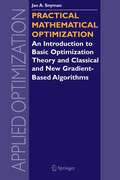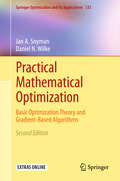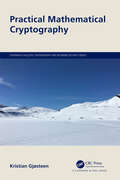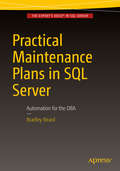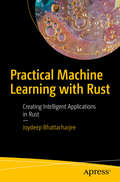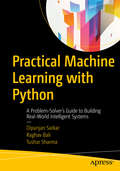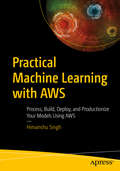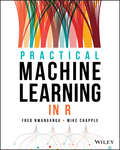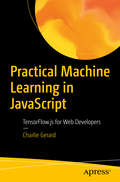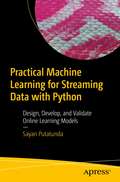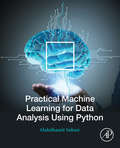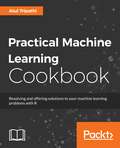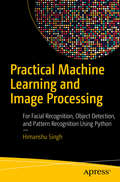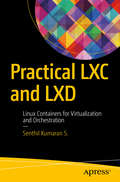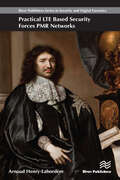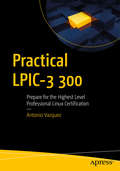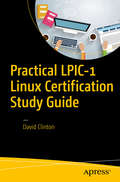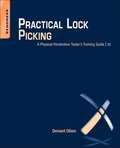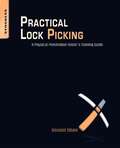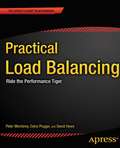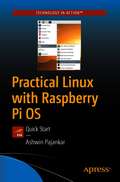- Table View
- List View
Practical Mathematical Optimization: An Introduction to Basic Optimization Theory and Classical and New Gradient-Based Algorithms (Applied Optimization #97)
by Jan SnymanThis book presents basic optimization principles and gradient-based algorithms to a general audience, in a brief and easy-to-read form. It enables professionals to apply optimization theory to engineering, physics, chemistry, or business economics.
Practical Mathematical Optimization: Basic Optimization Theory and Gradient-Based Algorithms (Springer Optimization and Its Applications #133)
by Jan A Snyman Daniel N WilkeThis book presents basic optimization principles and gradient-based algorithms to a general audience, in a brief and easy-to-read form. It enables professionals to apply optimization theory to engineering, physics, chemistry, or business economics.
Practical Mathematical Cryptography (Chapman & Hall/CRC Cryptography and Network Security Series)
by Kristian GjøsteenPractical Mathematical Cryptography provides a clear and accessible introduction to practical mathematical cryptography. Cryptography, both as a science and as practice, lies at the intersection of mathematics and the science of computation, and the presentation emphasises the essential mathematical nature of the computations and arguments involved in cryptography. Cryptography is also a practical science, and the book shows how modern cryptography solves important practical problems in the real world, developing the theory and practice of cryptography from the basics to secure messaging and voting. The presentation provides a unified and consistent treatment of the most important cryptographic topics, from the initial design and analysis of basic cryptographic schemes towards applications. Features Builds from theory toward practical applications Suitable as the main text for a mathematical cryptography course Focus on secure messaging and voting systems.
Practical Mathematical Cryptography (Chapman & Hall/CRC Cryptography and Network Security Series)
by Kristian GjøsteenPractical Mathematical Cryptography provides a clear and accessible introduction to practical mathematical cryptography. Cryptography, both as a science and as practice, lies at the intersection of mathematics and the science of computation, and the presentation emphasises the essential mathematical nature of the computations and arguments involved in cryptography. Cryptography is also a practical science, and the book shows how modern cryptography solves important practical problems in the real world, developing the theory and practice of cryptography from the basics to secure messaging and voting. The presentation provides a unified and consistent treatment of the most important cryptographic topics, from the initial design and analysis of basic cryptographic schemes towards applications. Features Builds from theory toward practical applications Suitable as the main text for a mathematical cryptography course Focus on secure messaging and voting systems.
Practical Maintenance Plans in SQL Server: Automation for the DBA
by Bradley BeardThis book is a complete guide to setting up and maintaining maintenance plans for SQL Server Database Administrators. Maintenance plans too often consist of a backup task and that’s it, but there is so much more that can and must be done to ensure the integrity of your most important company resource – the data you are tasked to manage and safeguard. This book walks even the newest of users through creating a powerful, automated maintenance plan. Automate your job using SQL Server Agent to leverage the power of Maintenance Plans to deliver real, proactive solutions to common issues. Schedule common tasks such as backups and index rebuilds to run automatically, and get early-warning notifications of impending problems relating to resource usage and query performance. By the time your boss knows to call you about a problem, you’ll have already called him to describe your solution. The large majority of books never really cover the topic of inheriting a database server with multiple live databases; the common thread is that the databases will be created and maintained by the reader forever and ever. In the real world, that scenario rarely happens. Practical Maintenance Plans in SQL Server covers that scenario and provides you with the knowledge and tools needed to get comfortable writing your own maintenance plans for any SQL Server database, whether created by you or inherited. Shows the different tasks that can be run in a maintenance plan.Explains how and why those tasks can be implemented.Provides a roadmap to creating your own custom maintenance plan.What You Will LearnImplement a completely automated backup maintenance planBe alerted to performance problems and outages ahead of your bossLearn the different types of database maintenance tasksPlan the workflow of tasks within a maintenance planAutomate your work by implementing custom maintenance plansWho This Book Is ForPractical Maintenance Plans in SQL Server is for any level of database administrator, but specifically it’s for those administrators with a real need to set up a powerful maintenance plan quickly. New and seasoned administrators will appreciate the book for its robust learning pattern of visual aids in combination with explanations and scenarios. Practical Maintenance Plans in SQL Server is the perfect “new hire” gift for new database administrators in any organization.
Practical Machine Learning with Rust: Creating Intelligent Applications in Rust
by Joydeep BhattacharjeeExplore machine learning in Rust and learn about the intricacies of creating machine learning applications. This book begins by covering the important concepts of machine learning such as supervised, unsupervised, and reinforcement learning, and the basics of Rust. Further, you’ll dive into the more specific fields of machine learning, such as computer vision and natural language processing, and look at the Rust libraries that help create applications for those domains. We will also look at how to deploy these applications either on site or over the cloud. After reading Practical Machine Learning with Rust, you will have a solid understanding of creating high computation libraries using Rust. Armed with the knowledge of this amazing language, you will be able to create applications that are more performant, memory safe, and less resource heavy. What You Will LearnWrite machine learning algorithms in RustUse Rust libraries for different tasks in machine learningCreate concise Rust packages for your machine learning applicationsImplement NLP and computer vision in RustDeploy your code in the cloud and on bare metal servers Who This Book Is For Machine learning engineers and software engineers interested in building machine learning applications in Rust.
Practical Machine Learning with Python: A Problem-Solver's Guide to Building Real-World Intelligent Systems
by Dipanjan Sarkar Raghav Bali Tushar SharmaMaster the essential skills needed to recognize and solve complex problems with machine learning and deep learning. Using real-world examples that leverage the popular Python machine learning ecosystem, this book is your perfect companion for learning the art and science of machine learning to become a successful practitioner. The concepts, techniques, tools, frameworks, and methodologies used in this book will teach you how to think, design, build, and execute machine learning systems and projects successfully.Practical Machine Learning with Python follows a structured and comprehensive three-tiered approach packed with hands-on examples and code. Part 1 focuses on understanding machine learning concepts and tools. This includes machine learning basics with a broad overview of algorithms, techniques, concepts and applications, followed by a tour of the entire Python machine learning ecosystem. Brief guides for useful machine learning tools, libraries and frameworks are also covered. Part 2 details standard machine learning pipelines, with an emphasis on data processing analysis, feature engineering, and modeling. You will learn how to process, wrangle, summarize and visualize data in its various forms. Feature engineering and selection methodologies will be covered in detail with real-world datasets followed by model building, tuning, interpretation and deployment. Part 3 explores multiple real-world case studies spanning diverse domains and industries like retail, transportation, movies, music, marketing, computer vision and finance. For each case study, you will learn the application of various machine learning techniques and methods. The hands-on examples will help you become familiar with state-of-the-art machine learning tools and techniques and understand what algorithms are best suited for any problem. Practical Machine Learning with Python will empower you to start solving your own problems with machine learning today!What You'll LearnExecute end-to-end machine learning projects and systemsImplement hands-on examples with industry standard, open source, robust machine learning tools and frameworksReview case studies depicting applications of machine learning and deep learning on diverse domains and industriesApply a wide range of machine learning models including regression, classification, and clustering.Understand and apply the latest models and methodologies from deep learning including CNNs, RNNs, LSTMs and transfer learning. Who This Book Is ForIT professionals, analysts, developers, data scientists, engineers, graduate students
Practical Machine Learning with AWS: Process, Build, Deploy, and Productionize Your Models Using AWS
by Himanshu SinghSuccessfully build, tune, deploy, and productionize any machine learning model, and know how to automate the process from data processing to deployment. This book is divided into three parts. Part I introduces basic cloud concepts and terminologies related to AWS services such as S3, EC2, Identity Access Management, Roles, Load Balancer, and Cloud Formation. It also covers cloud security topics such as AWS Compliance and artifacts, and the AWS Shield and CloudWatch monitoring service built for developers and DevOps engineers. Part II covers machine learning in AWS using SageMaker, which gives developers and data scientists the ability to build, train, and deploy machine learning models. Part III explores other AWS services such as Amazon Comprehend (a natural language processing service that uses machine learning to find insights and relationships in text), Amazon Forecast (helps you deliver accurate forecasts), and Amazon Textract.By the end of the book, you will understand the machine learning pipeline and how to execute any machine learning model using AWS. The book will also help you prepare for the AWS Certified Machine Learning—Specialty certification exam.What You Will LearnBe familiar with the different machine learning services offered by AWS Understand S3, EC2, Identity Access Management, and Cloud FormationUnderstand SageMaker, Amazon Comprehend, and Amazon ForecastExecute live projects: from the pre-processing phase to deployment on AWSWho This Book Is ForMachine learning engineers who want to learn AWS machine learning services, and acquire an AWS machine learning specialty certification
Practical Machine Learning on Databricks: Seamlessly transition ML models and MLOps on Databricks
by Debu SinhaTake your machine learning skills to the next level by mastering databricks and building robust ML pipeline solutions for future ML innovationsKey FeaturesLearn to build robust ML pipeline solutions for databricks transitionMaster commonly available features like AutoML and MLflowLeverage data governance and model deployment using MLflow model registryPurchase of the print or Kindle book includes a free PDF eBookBook DescriptionUnleash the potential of databricks for end-to-end machine learning with this comprehensive guide, tailored for experienced data scientists and developers transitioning from DIY or other cloud platforms. Building on a strong foundation in Python, Practical Machine Learning on Databricks serves as your roadmap from development to production, covering all intermediary steps using the databricks platform. You’ll start with an overview of machine learning applications, databricks platform features, and MLflow. Next, you’ll dive into data preparation, model selection, and training essentials and discover the power of databricks feature store for precomputing feature tables. You’ll also learn to kickstart your projects using databricks AutoML and automate retraining and deployment through databricks workflows. By the end of this book, you’ll have mastered MLflow for experiment tracking, collaboration, and advanced use cases like model interpretability and governance. The book is enriched with hands-on example code at every step. While primarily focused on generally available features, the book equips you to easily adapt to future innovations in machine learning, databricks, and MLflow.What you will learnTransition smoothly from DIY setups to databricksMaster AutoML for quick ML experiment setupAutomate model retraining and deploymentLeverage databricks feature store for data prepUse MLflow for effective experiment trackingGain practical insights for scalable ML solutionsFind out how to handle model drifts in production environmentsWho this book is forThis book is for experienced data scientists, engineers, and developers proficient in Python, statistics, and ML lifecycle looking to transition to databricks from DIY clouds. Introductory Spark knowledge is a must to make the most out of this book, however, end-to-end ML workflows will be covered. If you aim to accelerate your machine learning workflows and deploy scalable, robust solutions, this book is an indispensable resource.
Practical Machine Learning in R
by Fred Nwanganga Mike ChappleGuides professionals and students through the rapidly growing field of machine learning with hands-on examples in the popular R programming language Machine learning—a branch of Artificial Intelligence (AI) which enables computers to improve their results and learn new approaches without explicit instructions—allows organizations to reveal patterns in their data and incorporate predictive analytics into their decision-making process. Practical Machine Learning in R provides a hands-on approach to solving business problems with intelligent, self-learning computer algorithms. Bestselling author and data analytics experts Fred Nwanganga and Mike Chapple explain what machine learning is, demonstrate its organizational benefits, and provide hands-on examples created in the R programming language. A perfect guide for professional self-taught learners or students in an introductory machine learning course, this reader-friendly book illustrates the numerous real-world business uses of machine learning approaches. Clear and detailed chapters cover data wrangling, R programming with the popular RStudio tool, classification and regression techniques, performance evaluation, and more. Explores data management techniques, including data collection, exploration and dimensionality reduction Covers unsupervised learning, where readers identify and summarize patterns using approaches such as apriori, eclat and clustering Describes the principles behind the Nearest Neighbor, Decision Tree and Naive Bayes classification techniques Explains how to evaluate and choose the right model, as well as how to improve model performance using ensemble methods such as Random Forest and XGBoost Practical Machine Learning in R is a must-have guide for business analysts, data scientists, and other professionals interested in leveraging the power of AI to solve business problems, as well as students and independent learners seeking to enter the field.
Practical Machine Learning in R
by Fred Nwanganga Mike ChappleGuides professionals and students through the rapidly growing field of machine learning with hands-on examples in the popular R programming language Machine learning—a branch of Artificial Intelligence (AI) which enables computers to improve their results and learn new approaches without explicit instructions—allows organizations to reveal patterns in their data and incorporate predictive analytics into their decision-making process. Practical Machine Learning in R provides a hands-on approach to solving business problems with intelligent, self-learning computer algorithms. Bestselling author and data analytics experts Fred Nwanganga and Mike Chapple explain what machine learning is, demonstrate its organizational benefits, and provide hands-on examples created in the R programming language. A perfect guide for professional self-taught learners or students in an introductory machine learning course, this reader-friendly book illustrates the numerous real-world business uses of machine learning approaches. Clear and detailed chapters cover data wrangling, R programming with the popular RStudio tool, classification and regression techniques, performance evaluation, and more. Explores data management techniques, including data collection, exploration and dimensionality reduction Covers unsupervised learning, where readers identify and summarize patterns using approaches such as apriori, eclat and clustering Describes the principles behind the Nearest Neighbor, Decision Tree and Naive Bayes classification techniques Explains how to evaluate and choose the right model, as well as how to improve model performance using ensemble methods such as Random Forest and XGBoost Practical Machine Learning in R is a must-have guide for business analysts, data scientists, and other professionals interested in leveraging the power of AI to solve business problems, as well as students and independent learners seeking to enter the field.
Practical Machine Learning in JavaScript: TensorFlow.js for Web Developers
by Charlie GerardBuild machine learning web applications without having to learn a new language. This book will help you develop basic knowledge of machine learning concepts and applications. You’ll learn not only theory, but also dive into code samples and example projects with TensorFlow.js. Using these skills and your knowledge as a web developer, you’ll add a whole new field of development to your tool set. This will give you a more concrete understanding of the possibilities offered by machine learning. Discover how ML will impact the future of not just programming in general, but web development specifically. Machine learning is currently one of the most exciting technology fields with the potential to impact industries from health to home automation to retail, and even art. Google has now introduced TensorFlow.js—an iteration of TensorFlow aimed directly at web developers. Practical Machine Learning in JavaScript will help you stay relevant in the tech industry with new tools, trends, and best practices.What You'll LearnUse the JavaScript framework for MLBuild machine learning applications for the webDevelop dynamic and intelligent web contentWho This Book Is ForWeb developers and who want a hands-on introduction to machine learning in JavaScript. A working knowledge of the JavaScript language is recommended.
Practical Machine Learning for Streaming Data with Python: Design, Develop, and Validate Online Learning Models
by Sayan PutatundaDesign, develop, and validate machine learning models with streaming data using the Scikit-Multiflow framework. This book is a quick start guide for data scientists and machine learning engineers looking to implement machine learning models for streaming data with Python to generate real-time insights. You'll start with an introduction to streaming data, the various challenges associated with it, some of its real-world business applications, and various windowing techniques. You'll then examine incremental and online learning algorithms, and the concept of model evaluation with streaming data and get introduced to the Scikit-Multiflow framework in Python. This is followed by a review of the various change detection/concept drift detection algorithms and the implementation of various datasets using Scikit-Multiflow.Introduction to the various supervised and unsupervised algorithms for streaming data, and their implementation on various datasets using Python are also covered. The book concludes by briefly covering other open-source tools available for streaming data such as Spark, MOA (Massive Online Analysis), Kafka, and more.What You'll LearnUnderstand machine learning with streaming data conceptsReview incremental and online learningDevelop models for detecting concept driftExplore techniques for classification, regression, and ensemble learning in streaming data contextsApply best practices for debugging and validating machine learning models in streaming data contextGet introduced to other open-source frameworks for handling streaming data.Who This Book Is ForMachine learning engineers and data science professionals
Practical Machine Learning for Data Analysis Using Python
by Abdulhamit SubasiPractical Machine Learning for Data Analysis Using Python is a problem solver’s guide for creating real-world intelligent systems. It provides a comprehensive approach with concepts, practices, hands-on examples, and sample code. The book teaches readers the vital skills required to understand and solve different problems with machine learning. It teaches machine learning techniques necessary to become a successful practitioner, through the presentation of real-world case studies in Python machine learning ecosystems. The book also focuses on building a foundation of machine learning knowledge to solve different real-world case studies across various fields, including biomedical signal analysis, healthcare, security, economics, and finance. Moreover, it covers a wide range of machine learning models, including regression, classification, and forecasting. The goal of the book is to help a broad range of readers, including IT professionals, analysts, developers, data scientists, engineers, and graduate students, to solve their own real-world problems.Offers a comprehensive overview of the application of machine learning tools in data analysis across a wide range of subject areasTeaches readers how to apply machine learning techniques to biomedical signals, financial data, and healthcare dataExplores important classification and regression algorithms as well as other machine learning techniquesExplains how to use Python to handle data extraction, manipulation, and exploration techniques, as well as how to visualize data spread across multiple dimensions and extract useful features
Practical Machine Learning Cookbook
by Atul TripathiResolving and offering solutions to your machine learning problems with R About This Book • Implement a wide range of algorithms and techniques for tackling complex data • Improve predictions and recommendations to have better levels of accuracy • Optimize performance of your machine-learning systems Who This Book Is For This book is for analysts, statisticians, and data scientists with knowledge of fundamentals of machine learning and statistics, who need help in dealing with challenging scenarios faced every day of working in the field of machine learning and improving system performance and accuracy. It is assumed that as a reader you have a good understanding of mathematics. Working knowledge of R is expected. What You Will Learn • Get equipped with a deeper understanding of how to apply machine-learning techniques • Implement each of the advanced machine-learning techniques • Solve real-life problems that are encountered in order to make your applications produce improved results • Gain hands-on experience in problem solving for your machine-learning systems • Understand the methods of collecting data, preparing data for usage, training the model, evaluating the model's performance, and improving the model's performance In Detail Machine learning has become the new black. The challenge in today's world is the explosion of data from existing legacy data and incoming new structured and unstructured data. The complexity of discovering, understanding, performing analysis, and predicting outcomes on the data using machine learning algorithms is a challenge. This cookbook will help solve everyday challenges you face as a data scientist. The application of various data science techniques and on multiple data sets based on real-world challenges you face will help you appreciate a variety of techniques used in various situations. The first half of the book provides recipes on fairly complex machine-learning systems, where you'll learn to explore new areas of applications of machine learning and improve its efficiency. That includes recipes on classifications, neural networks, unsupervised and supervised learning, deep learning, reinforcement learning, and more. The second half of the book focuses on three different machine learning case studies, all based on real-world data, and offers solutions and solves specific machine-learning issues in each one. Style and approach Following a cookbook approach, we'll teach you how to solve everyday difficulties and struggles you encounter.
Practical Machine Learning and Image Processing: For Facial Recognition, Object Detection, and Pattern Recognition Using Python
by Himanshu SinghGain insights into image-processing methodologies and algorithms, using machine learning and neural networks in Python. This book begins with the environment setup, understanding basic image-processing terminology, and exploring Python concepts that will be useful for implementing the algorithms discussed in the book. You will then cover all the core image processing algorithms in detail before moving onto the biggest computer vision library: OpenCV. You’ll see the OpenCV algorithms and how to use them for image processing. The next section looks at advanced machine learning and deep learning methods for image processing and classification. You’ll work with concepts such as pulse coupled neural networks, AdaBoost, XG boost, and convolutional neural networks for image-specific applications. Later you’ll explore how models are made in real time and then deployed using various DevOps tools. All the concepts in Practical Machine Learning and Image Processing are explained using real-life scenarios. After reading this book you will be able to apply image processing techniques and make machine learning models for customized application.What You Will LearnDiscover image-processing algorithms and their applications using PythonExplore image processing using the OpenCV libraryUse TensorFlow, scikit-learn, NumPy, and other librariesWork with machine learning and deep learning algorithms for image processingApply image-processing techniques to five real-time projectsWho This Book Is ForData scientists and software developers interested in image processing and computer vision.
Practical LXC and LXD: Linux Containers for Virtualization and Orchestration
by Senthil Kumaran S.Use Linux containers as an alternative virtualization technique to virtualize your operating system environment. This book will cover LXC’s unmatched flexibility with virtualization and LXD’s smooth user experience.Practical LXC and LXD begins by introducing you to Linux containers (LXC and LXD). You will then go through use cases based on LXC and LXD. Next, you will see the internal workings of LXC and LXD by considering the repositories and templates used. You will then learn how to integrate LXC and LXD with common virtualization and orchestration tools such as libvirt and SaltStack. Finally, you will dive into containerization and security. The book will explore some of the common problems in security and provide a case study on how containerization can help mitigate some of the operating system-level security issues in an IoT environment.What You Will LearnGet an introduction to Linux containersDiscover the basics of LXC and LXDSee use cases that can be solved with LXC and LXD – for developers, devops, and system administratorsMaster LXC and LXD repositoriesUse LXC and LXD with common virtualization and orchestration toolsConsider a containerization and security in IoT case studyWho This Book Is ForThe audience for this book should have basic knowledge of Linux and software development in general. The intended readership is primarily software developers, operations engineers, and system administrators who are interested in devops, though managers and enthusiasts will also benefit from this book.
Practical LTE based security forces PMR networks
by Arnaud Henry-LabordèreSecurity forces PMR networks are moving from proprietary technologies for their Mission Critical Push-To-Talk basic service, and their data services which must provide large bandwidth real-time access, to the databases. LTE Based is adopted with backup access to public MNOs to complement their own radio coverage. Specific technologies such as multicasting of visio are required so the MCPTT works within a restricted bandwidth. The need to be able to change the main MNOs to provide resilient coverage requires specific choices of SIM cards, with OTAble security domains. Practical LTE Based Security Forces PMR Networks assumes that the reader has a basic knowledge of the 4G network architecture and services, and the book focusses on the specific features and choices required to fulfill the need of security forces PMR networks. These include tactical and centralized, including LTE based voice services VoLTE and IMS. It can be used as a reference or textbook, with many detailed call flows and traces being included. The author, who has also a long teaching career in Operations Research, provides mathematical models for the optimization of tactical network federations, multicast coverage and allocation of preemptive priorities to PMR group members. He is a pioneer in the area of Virtual Roaming, an application of graph theory and telecommunications to provide roaming without direct relations, having previously published books on SMS Hubs, SS7 Hubs, Diameter Hubs, GTP Hubs. The use of M2M (monitoring devices) for security forces with mobility is covered in detail in the book, including the new LoRa virtual roaming which goes beyond the scope of PMR.
Practical LTE based security forces PMR networks
by Arnaud Henry-LabordèreSecurity forces PMR networks are moving from proprietary technologies for their Mission Critical Push-To-Talk basic service, and their data services which must provide large bandwidth real-time access, to the databases. LTE Based is adopted with backup access to public MNOs to complement their own radio coverage. Specific technologies such as multicasting of visio are required so the MCPTT works within a restricted bandwidth. The need to be able to change the main MNOs to provide resilient coverage requires specific choices of SIM cards, with OTAble security domains. Practical LTE Based Security Forces PMR Networks assumes that the reader has a basic knowledge of the 4G network architecture and services, and the book focusses on the specific features and choices required to fulfill the need of security forces PMR networks. These include tactical and centralized, including LTE based voice services VoLTE and IMS. It can be used as a reference or textbook, with many detailed call flows and traces being included. The author, who has also a long teaching career in Operations Research, provides mathematical models for the optimization of tactical network federations, multicast coverage and allocation of preemptive priorities to PMR group members. He is a pioneer in the area of Virtual Roaming, an application of graph theory and telecommunications to provide roaming without direct relations, having previously published books on SMS Hubs, SS7 Hubs, Diameter Hubs, GTP Hubs. The use of M2M (monitoring devices) for security forces with mobility is covered in detail in the book, including the new LoRa virtual roaming which goes beyond the scope of PMR.
Practical LPIC-3 300: Prepare for the Highest Level Professional Linux Certification
by Antonio VazquezGain the essential skills and hands-on expertise required to pass the LPIC-3 300 certification exam. This book provides the insight for you to confidently install, manage and troubleshoot OpenLDAP, Samba, and FreeIPA. Helping you to get started from scratch, this guide is divided into three comprehensive sections covering everything you'll need to prepare for the exam.Part 1 focuses on OpenLDAP and topics including securing the directory, integration with PAM and replication. Part 2 covers Samba and teaches you about Samba architecture, using different back ends, print services, and deploying Samba as a stand-alone server, PDC, and Active Directory Domain Controller. Finally, Part 3 explains how to manage FreeIPA and how to integrate it with Active Directory.Practical LPIC-3 300 is the perfect study guide for anyone interested in the LPIC-3 300 certification exam, OpenLDAP, Samba, or FreeIPA.What You'll Learn Integrate LDAP with PAM and NSS, and with Active Directory and KerberosManage OpenLDAP replication and server performance tuningUse Samba as a PDC and BDCConfigure Samba as a domain member server in an existing NT domainUse Samba as an AD Compatible Domain ControllerReplicate, manage, and integrate FreeIPA Who This Book Is For This book is for anyone who is preparing for the LPIC-3 300 exam, or those interested in learning about OpenLDAP and Samba in general.
Practical LPIC-1 Linux Certification Study Guide
by David ClintonThis book is your complete guide to studying for the Linux Professional Institute's Server Professional (LPIC-1) certification. Every concept, principle, process, and resource that might make an appearance on the exam is fully represented. You will understand every concept by rolling up your sleeves, opening up a terminal, and trying it all yourself. You will find suggestions for practical tasks along with "test-yourself" quizzes at the end of each chapter.Whether you've decided to earn the Linux Professional Institute's Server Professional certification or you simply want to learn more about Linux administration, this book is a great choice. Right now, Linux administration skills are opening doors to some of the hottest job markets. And with the ongoing explosive growth of the cloud computing world - the vast majority of which is being built with Linux - the scope of the opportunities will only increase. Whether or not you end up taking the exam, if you manage to learn this material, you'll have done yourself a real favor. What You Will LearnBasic Linux system administration and package managementDevice and desktop managementBash scripting Networking fundamentalsSecurity administrationWho This Book Is For Most potential readers will already have a decent idea of what Linux is and what kinds of things can be done with it, and are looking to acquire or formalize a more structured and complete ability to confidently administrate Linux systems.
Practical Lock Picking: A Physical Penetration Tester's Training Guide
by Deviant OllamPractical Lock Picking, Second Edition, is an instructional manual that covers everything from straightforward lockpicking to quick-entry techniques such as shimming, bumping, and bypassing. Written by Deviant Ollam, one of the security industry's best-known lockpicking teachers, and winner of the Best Book Bejtlich Read in 2010 award, this book contains detailed photos that make learning as easy as picking a lock. Material is offered in easy-to-follow lessons that allow even beginners to acquire the knowledge very quickly. Whether the student will be hired at some point to penetrate security or simply trying to harden his or her own defenses, this book is essential. This edition has been updated to reflect the changing landscape of tools and tactics which have emerged in recent years. It consists of 6 chapters that discuss topics such as the fundamentals of pin tumbler and wafer locks; the basics of picking, with emphasis on how to exploit weaknesses; tips for beginners on how to get very good and very fast in picking locks; advanced training; quick-entry tricks about shimming, bumping, and bypassing; and pin tumblers in other configurations. This book is geared specifically toward penetration testers, security consultants, IT security professionals, and hackers.Detailed full-color photos make learning as easy as picking a lockExtensive appendix details tools and toolkits currently available for all your lock picking needs
Practical Lock Picking: A Physical Penetration Tester's Training Guide
by Deviant OllamPractical Lock Picking: A Physical Penetration Tester’s Training Guide introduces the reader to the basic principles of lock picking. The book combines both easy-to-follow, step-by-step lessons, and tutorials that will help security-conscious people learn how to open most of the locks they may encounter during auditing or assessment work. It covers the fundamentals of pin tumbler and wafer locks; the basics of picking; beginner and advanced training; and quick entry techniques. Whether the student will be hired at some point to penetrate security or simply trying to harden his or her own defenses, this book is essential. This instructional manual focuses on pin tumbler locks, the construction and function of which are illustrated with the aid of several diagrams. Everything from straightforward lock picking to quick-entry techniques like shimming, bumping, and bypassing are explained and shown. Guides and exercises demonstrate the use of basic lock-picking tools in order to manipulate and open these locks. The text also describes the most common "alternative" designs of pin tumbler locks and summarizes the tools and techniques that can be effective against them. It comes with a DVD filled with indispensable lock picking videos and color photos. This book is an ideal reference for penetration testers, security consultants, and IT security professionals as well as hackers.Detailed photos make learning as easy as picking a lockDVD is filled with indispensible lock picking videos and color photosExtensive appendix details tools and toolkits currently available for all your lock picking needs
Practical Load Balancing: Ride the Performance Tiger
by Peter Membrey Eelco Plugge David HowsThe emergence of the cloud and modern, fast corporate networks demands that you perform judicious balancing of computational loads. Practical Load Balancing presents an entire analytical framework to increase performance not just of one machine, but of your entire infrastructure. Practical Load Balancing starts by introducing key concepts and the tools you'll need to tackle your load-balancing issues. You'll travel through the IP layers and learn how they can create increased network traffic for you. You'll see how to account for persistence and state, and how you can judge the performance of scheduling algorithms. You'll then learn how to avoid performance degradation and any risk of the sudden disappearance of a service on a server. If you're concerned with running your load balancer for an entire network, you'll find out how to set up your network topography, and condense each topographical variety into recipes that will serve you in different situations. You'll also learn about individual servers, and load balancers that can perform cookie insertion or improve your SSL throughput. You'll also explore load balancing in the modern context of the cloud. While load balancers need to be configured for high availability once the conditions on the network have been created, modern load balancing has found its way into the cloud, where good balancing is vital for the very functioning of the cloud, and where IPv6 is becoming ever more important. You can read Practical Load Balancing from end to end or out of sequence, and indeed, if there are individual topics that interest you, you can pick up this book and work through it once you have read the first three chapters.
Practical Linux with Raspberry Pi OS: Quick Start
by Ashwin PajankarQuickly start programming with Linux while learning the Raspberry Pi OS—the Linux distribution designed specifically for low-cost Raspberry Pis. This short guide reviews Linux commands, GUI, and shell scripting in a holistic manner by diving into both advanced and day-to-day tasks using the Raspberry Pi OS.You'll comfortably work with the Linux command prompt, and explore the RPi OS GUI and all its base applications. Then move into writing your own programs with shell-programming and using high-level languages such as C, C++, and Python 3. You’ll also study hardware and GPIO programming. Use Python 3 for GPIO programming to drive LEDs and pushbuttons.Examples are written in Shell, C, C++, and Python 3. Graphical output is displayed in helpful screenshots that capture just what you’ll see when working in this environment. All code examples are well tested on actual Raspberry Pi boards. After reading this book and following the examples, you’ll be able to write programs for demonstration in your academic/industrial research work, business environment, or just your circle of friends for fun! What You'll LearnNavigate the core aspects of Linux and programming on a Linux platform Install Raspberry Pi OS on a Raspberry PiProgram in Shell, C, C++, and PythonRedirect Io and work with the crontabWho This Book Is ForLinux enthusiasts, software engineers, researchers, business analysts, and managers working with the low-cost Raspberry Pi.
